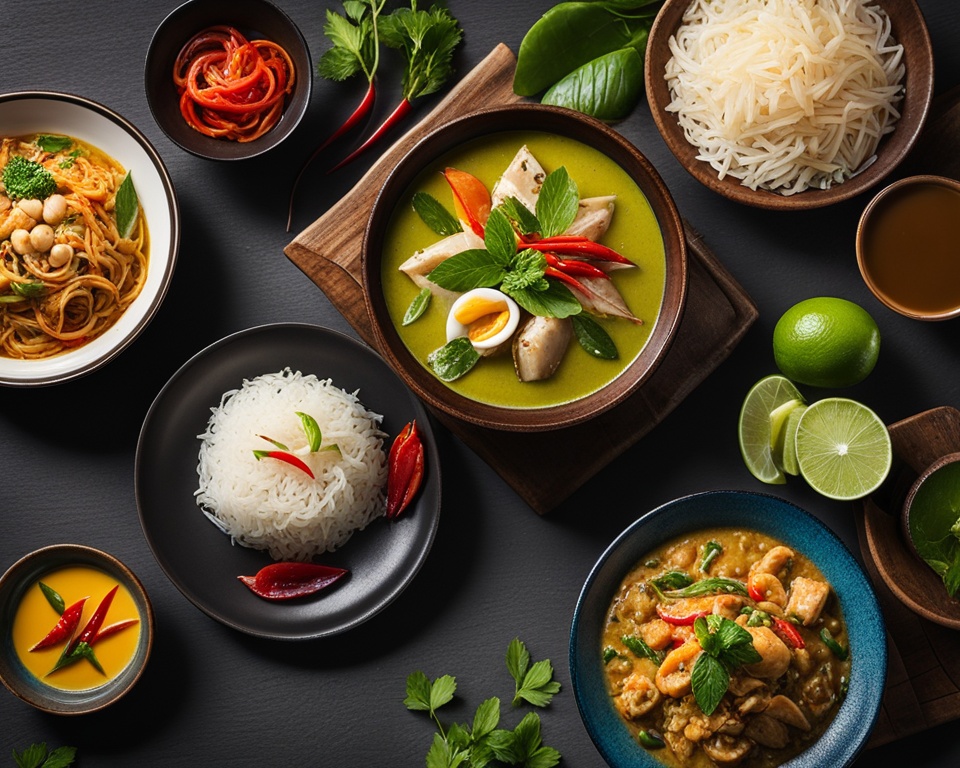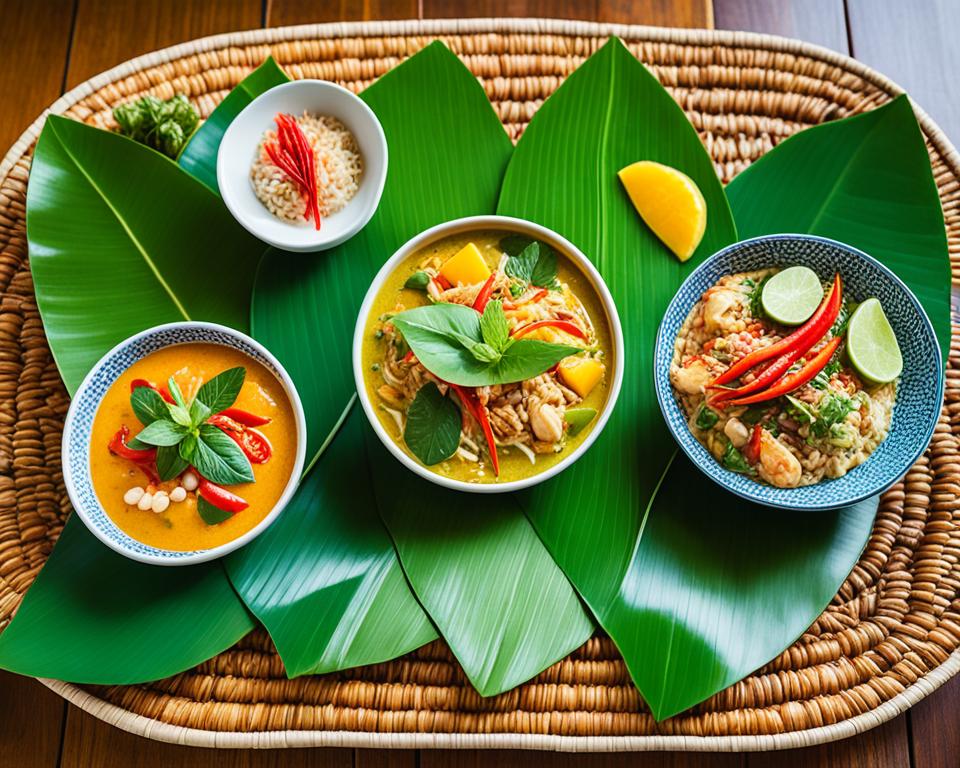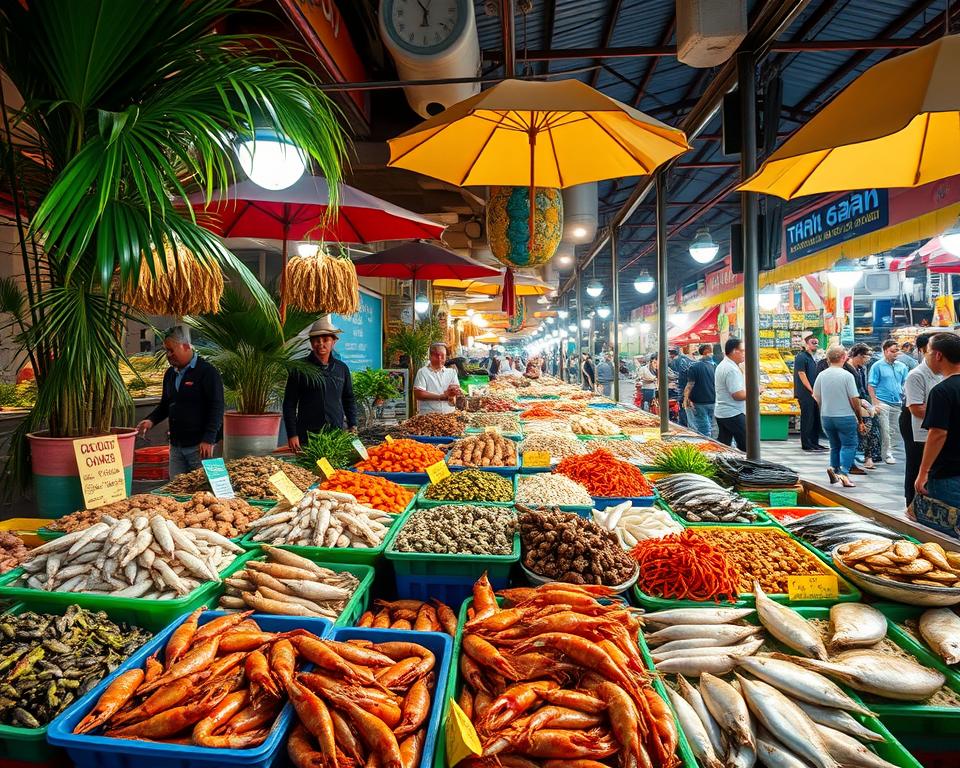Embark on a culinary adventure with Thai food recipes. Explore the vibrant and flavorful Thai cuisine world. Learn the authentic flavors and methods in this guide. It has everything from the classics to authentic Thai dishes.
Learn about Thai ingredients that make this cuisine stand out. Discover popular Thai recipes with sweet, sour, spicy, and savory tastes. Whether a new or experienced cook, this guide helps you. With its knowledge and techniques, you’ll prepare Thai meal prep favorites.
Immerse in rich Thai food culture and each dish’s importance. From spicy Thai curries to desserts, this guide has it all. Start your culinary journey. Find the best Thai food recipes to bring Thailand’s authentic flavors to your kitchen.
Read more interesting information at ::kamarqgroup
Explore the Vibrant World of Thai Cuisine
Thai cuisine is known for its wonderful mix of tastes. The vibrant flavors come together like a well-played symphony. Lemongrass and kaffir lime create a fresh base. Add in fish sauce and spicy curries, and you’re on a journey through Thai food‘s wonderful flavors.
Understanding Thai Food’s Unique Flavors
Authentic Thai dishes are all about balance. They balance sweet, sour, salty, and spicy perfectly. This mix comes from using ingredients like palm sugar, fish sauce, and chilies. They all work together to make every bite exciting and fulfilling.
The Importance of Authentic Ingredients
Real Thai cuisine shines with the right Thai ingredients. Kaffir lime leaves and galangal root are just starters. Using these ingredients is crucial to experiencing the true Thai flavors. They take you on a journey to Thailand’s lively streets with every dish.
“Thai food is not just a cuisine, it’s a way of life. Each bite is a symphony of flavors, a celebration of the senses.”
Exploring Thai cuisine reveals centuries of culinary culture. By focusing on unique flavors and real ingredients, you dive into a vibrant culinary tradition.
Essential Thai Ingredients and Flavors
Thai cuisine is a colorful adventure filled with unique flavors. Essential ingredients like fish sauce and galangal have a special role. They make Thai dishes stand out with their taste. Learning how to find and use these ingredients is vital for real Thai meals in your kitchen.
Fish sauce is key in Thai cooking, made by fermenting fish. It adds a rich and complex flavor to dishes like stir-fries and curries. Shrimp paste also plays a big role, offering a unique briny taste. Galangal looks like ginger but tastes citrusy. Lemongrass brings a fresh, lemon-like scent to meals.
| Thai Ingredient | Flavor Profile | Uses in Thai Cooking |
|---|---|---|
| Fish Sauce | Umami, savory | Stir-fries, curries, marinades |
| Shrimp Paste | Briny, pungent | Curries, dips, sauces |
| Galangal | Citrusy, slightly spicy | Soups, curries, stir-fries |
| Lemongrass | Lemony, floral | Soups, curries, marinades |
| Coconut Milk | Rich, creamy | Curries, desserts, sauces |
Coconut milk adds a rich, creamy element to Thai recipes, like curries and desserts. It’s all about finding the right balance of sweet, sour, salty, and spicy. These elements together make Thai cuisine so delightful.
To cook Thai food like a pro, you must know these essential ingredients. By diving into Thailand’s traditional tastes, you can add them to your own meals. This is how you make true Thai dishes that you love at home.
best thai food recipes: Iconic Thai Dishes to Try
Discover Thailand’s top dishes with our best Thai food recipes. You can learn to make Pad Thai, the classic noodle dish. And try your hand at the famous Tom Yum Goong soup. These iconic recipes share the secrets of Thai flavors with the world.
Pad Thai: The Classic Noodle Dish
Pad Thai is famous worldwide as a Thai street food favorite. It’s a stir-fried noodle dish with sweet, sour, and savory tastes. It includes shrimp, tofu, peanuts, and fresh herbs. Learn to cook this favorite dish and enjoy true Thai flavor at home.
Tom Yum Goong: Spicy Shrimp Soup
The list of best Thai food recipes must include Tom Yum Goong. This spicy shrimp soup is full of bright tastes like lemongrass and kaffir lime. With galangal and fresh shrimp, it’s a journey to Thailand with every spoonful. Experience the vibrant aromas and flavors of Thailand with this dish.
| Dish | Key Ingredients | Flavor Profile |
|---|---|---|
| Pad Thai | Rice noodles, shrimp, tofu, peanuts, bean sprouts, eggs, tamarind, fish sauce | Sweet, sour, savory |
| Tom Yum Goong | Shrimp, lemongrass, kaffir lime leaves, galangal, fish sauce, lime juice, chili peppers | Spicy, sour, fragrant |
“Thai food is so simple yet so incredibly delicious. The flavors are so unique, but the dishes are easy to make at home.” – Chef David Thompson, renowned Thai cuisine expert
Are you a Thai food fan? Or are you ready to start exploring Thai cuisine? Our recipes are perfect for anyone. Dive into dishes loved around the world. Learn the secrets to making these special meals in your own kitchen.
Mastering Thai Curries
Thai curries are known for their rich flavors and bright colors. From the creamy green curry to the red and yellow hot ones, each dish is a delight. Learn how to make Thai curries yourself. Discover the key steps and ingredients for these tasty meals.
Green Curry: A Fragrant Coconut Delight
The green curry is a top pick among spicy Thai curries. It blends fresh green chili peppers, lemongrass, and more. The mix of coconut milk and spices creates a dish you won’t forget.
| Key Ingredients for Green Curry | Flavor Profile |
|---|---|
|
|
Creating green curry is about finding the right mix of spicy, herbal, and coconut flavors. Practice and the best ingredients will make your kitchen feel like Thailand. Your taste buds will thank you.
“Thai curries are a harmonious symphony of flavors, where each ingredient plays a vital role in creating a truly captivating culinary experience.”
Thai Street Food: Delicious On-the-Go Eats
Enter the lively realm of Thai street food. Here, each bite bursts with amazing flavors. You find everything from tasty skewers to crunchy fritters. It’s a window into Thai culture’s heart and soul. Try making these dishes at home to enjoy easy Thai meal prep.
The Moo Ping stands out – juicy pork skewers full of flavor. They’re soaked in fish sauce, palm sugar, and spices. These treats are great with sticky rice and a sour sauce, perfect for eating on the move. Also, there’s the Khao Niaow Ma Muang, sticky rice with mango and coconut milk, a sweet choice.
Next, try Khao Kreb – crispy rice crackers. They’re a favorite among street food, often spice up with shallots and salt. They offer a pleasant crunch with each munch.
Don’t miss the Pad Thai for the full street food experience. This noodle dish blends sweet, sour, and savory tastes perfectly. Make it at home with noodles, shrimp, bean sprouts, and peanuts. Top it off with a delectable sauce that mirrors the real deal.
If you want a fast yet tasty meal, or just love exploring Thai cuisine, these recipes are for you. They bring the lively spirit of Thai streets straight to your kitchen. Dive into the rich flavors and simple joys of these dishes. It’s a culinary journey that will have you coming back for more.
Vegetarian and Vegan Thai Recipes
Discover the amazing world of vegetarian and vegan Thai food. You’ll find meat-free takes on favorites and exciting new dishes. These recipes use traditional Thai flavors and methods to make vegetarian thai recipes and vegan thai recipes. Get ready for a feast for your senses.
Flavorful Meat-Free Thai Dishes
Thai food is rich in taste, thanks to its complex flavors. The best part is, you can achieve those bold tastes without meat. Try vegetarian and vegan dishes that stay true to Thai culinary roots.
- Tofu Pad Thai: A twist on the noodle favorite, mixed with crispy tofu and tasty tamarind.
- Vegetable Red Curry: A creamy, coconut curry packed with veggies and aromatic spices.
- Mango Sticky Rice: A traditional dessert with sweet sticky rice, mango, and coconut sauce.
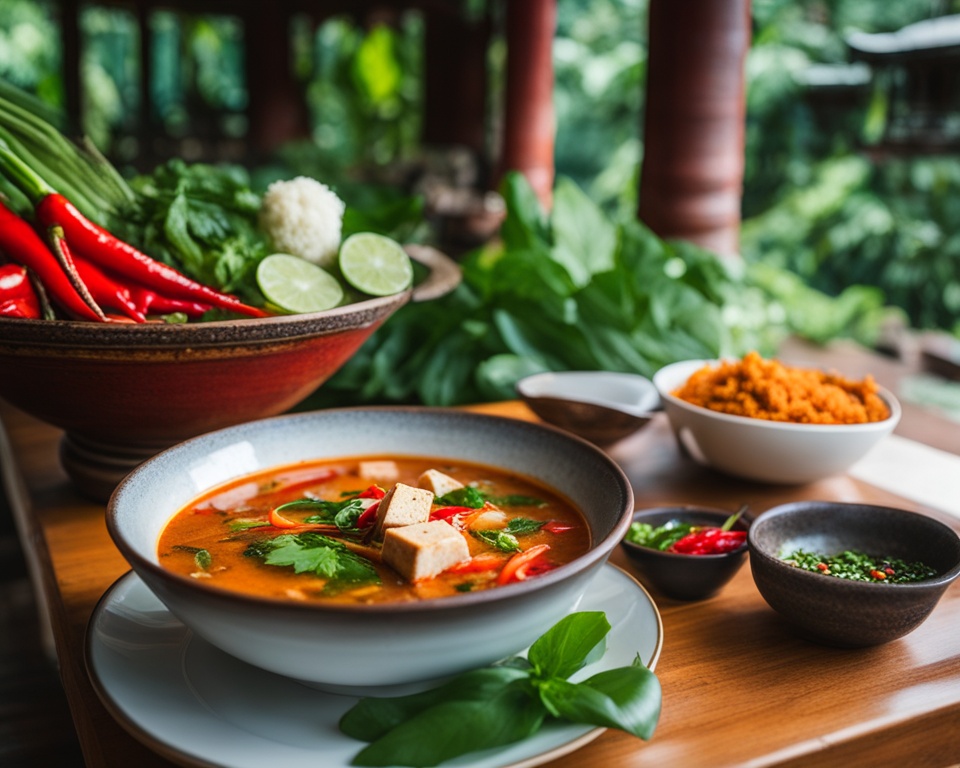
“Thai cuisine is all about balance and harmony of flavors. By focusing on fresh, high-quality ingredients, you can create truly authentic and delicious vegetarian and vegan Thai dishes.”
With a bit of creativity, you can turn Thai cookery into meatless wonders. Dive into the world of vegetarian thai recipes and vegan thai recipes to broaden your cooking skills. Enjoy the journey of exploring these colorful, fragrant, healthy meals.
Thai Desserts: Sweet Treats to Savor
Step into the delightful world of Thai desserts. Here, traditional Thai tastes dance in sweet symphonies. You’ll find everything from smooth coconut puddings to scented sticky rice dishes. Thai sweets are a perfect ending to any meal.
Take a tasty tour through traditional Thai flavors. Enjoy the textures and blends that make each dessert special. It’s the best way to finish a Thai feast.
Creamy Coconut Delights
Coconut milk is key in Thai sweets, adding silkiness and sweetness. Try the Thai coconut pudding with chewy tapioca pearls. It’s a flavor adventure you won’t forget.
Fragrant Sticky Rice Dishes
Sticky rice is not just for meals, it’s a dessert star too. Taste the mango sticky rice, with ripe mango, sticky rice, and coconut sauce. This mix of flavors and textures is heavenly.
A Harmony of Flavors
Thai desserts are known for their mix of tastes. The Thai custard mixes egg and palm sugar perfectly. Or try sweet sticky rice with taro for a delicious contrast.
Explore the amazing world of Thai desserts. Experience the mix of classic Thai flavors and new ideas. Whether you love coconut treats or sticky rice dishes, Thai sweets will win your heart.
Traditional Thai Cooking Methods
Thai cuisine is loved for its bright taste, fine balance, and detailed cooking ways. The wok is central to this, serving as a key tool for Thai cooking for many years. It’s versatile and perfect for many cooking tasks.
Mastering the Wok
The wok is key in Thai cooking. It helps chefs sear, stir-fry, and steam food quickly. Knowing how to use a wok well lets you make traditional Thai dishes with true taste and feel at home.
A crucial skill for Thai meal prep is high-heat stir-frying. When the chef tosses the food fast, everything mixes perfectly. Each mouthful feels like it’s straight from Thailand.
- Maintain a high heat to achieve the perfect sear and caramelization on the ingredients.
- Use a chopstick or spatula to continuously stir and toss the food, ensuring even cooking.
- Add ingredients in the right order, starting with the heartier items and finishing with delicate components.
The wok is also key for steaming. This gentle method keeps the food’s tastes and nutrients. By using a bit of liquid and covering the wok, chefs can steam all sorts of food.
| Cooking Technique | Purpose | Recommended Ingredients |
|---|---|---|
| Stir-frying | Quickly searing and tossing ingredients over high heat | Meat, seafood, vegetables, noodles |
| Steaming | Gently cooking ingredients while preserving flavor and nutrients | Delicate proteins, vegetables, rice dishes |
Learning to use a wok well is very important in traditional Thai cooking. With time and the right guidance, anyone can learn the secrets. This way, you can enjoy Thailand’s lively tastes in your kitchen too.
Meal Prep: Batch Cooking Thai Favorites
Want to up your Thai food game? Our meal prep guide for Thai favorites is here to help. It shows you how to enjoy Thailand’s delicious tastes any day. Perfect for busy folks or anyone looking to simplify their cooking, these steps save time and keep the flavors authentic.
Knowing how to use common Thai ingredients is the first step. From lemongrass and kaffir lime leaves to creamy coconut milk, these make Thai food special. Preparing these parts early cuts down on the time you spend cooking during the week. This includes your thai meal prep and best thai food recipes.
Batch Cooking Thai Staples
First, chop and freeze herbs and spices. They’ll keep well and stay fresh in the freezer. Next, whip up curry pastes and freeze them in small portions. Cooking a big batch of rice, whether jasmine or sticky, is another great tip.
- Chop and freeze lemongrass, kaffir lime leaves, and galangal
- Blend and freeze individual servings of red, green, or yellow curry paste
- Cook large batches of jasmine or sticky rice
Batch Cooking Thai Dishes
With your staples ready, making Thai meals is quick. Try dishes like Pad Thai, Tom Yum Goong, or Green Curry in bulk. Portion them out for easy, tasty meals whenever you want.
- Prepare Pad Thai noodles in big batches, mix with veggies and sauce
- Make a lot of Tom Yum Goong soup, then freeze single servings
- Cook a bunch of Green Curry, portion it, and you’re all set
Batch cooking means always having Thai food basics ready to go. It makes enjoying thai meal prep and thai food recipes so easy every day.
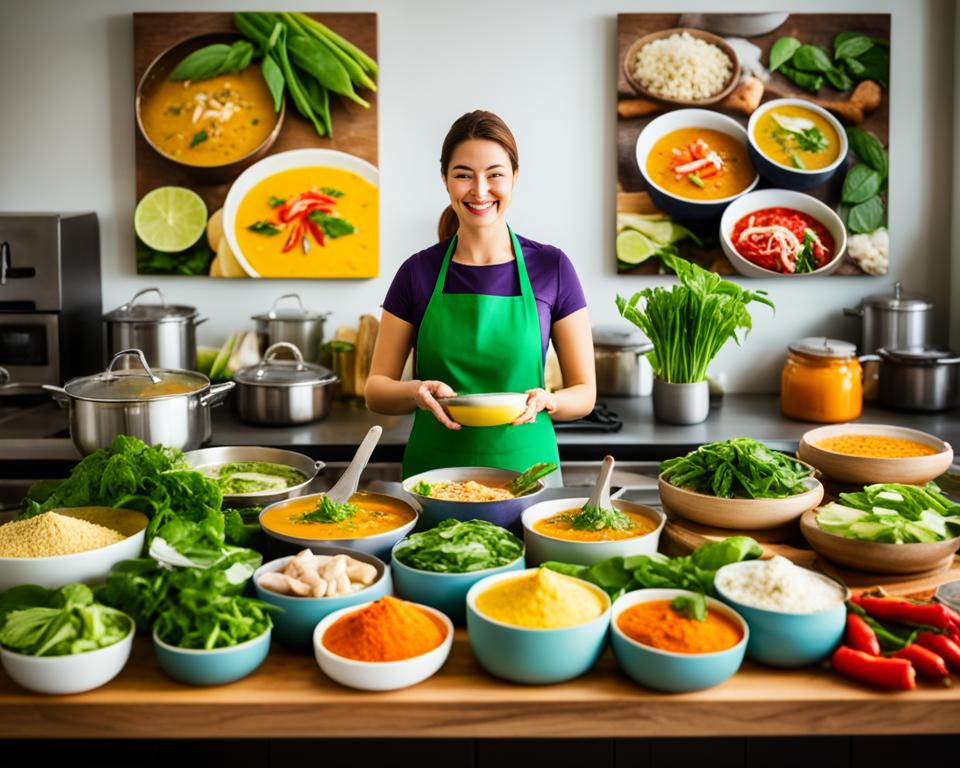
| Ingredient | Prep Ahead | Time Saved |
|---|---|---|
| Lemongrass, Kaffir Lime Leaves, Galangal | Chop and freeze | 10 minutes per recipe |
| Curry Pastes | Blend and freeze individual servings | 15 minutes per batch |
| Jasmine or Sticky Rice | Cook in large batches | 20 minutes per batch |
| Pad Thai, Tom Yum Goong, Green Curry | Prepare in large batches, portion and freeze | 30-45 minutes per dish |
“Meal prepping Thai favorites is a game-changer for busy cooks. With a little advance preparation, you can enjoy the vibrant flavors of Thailand any night of the week.”
The Cultural Significance of Thai Food
Thai cuisine is a rich mix of flavors and cultural heritage. For centuries, Thai society has blended unique identity, beliefs, and celebrations in their food. The thai food culture reflects the spirit of the Thai people. To truly enjoy traditional thai flavors, it’s vital to know their cultural values.
The heart of Thai cooking is love for nature. Thai dishes use ingredients from the country’s varied landscapes and climates. For example, you’ll find lemongrass and kaffir lime leaves from the tropical forests. Also, robust chilies and spices from the highlands show the connection between food and nature.
Thai food is prepared with spiritual beliefs in mind. The concept of balance is crucial. Chefs skillfully combine flavors, textures, and colors for a great dining experience. This balance key shows the Thai people’s deep belief in harmony with nature.
“Thai cuisine is not just about the food, but about the entire dining experience—the aromas, the textures, the colors, and the connection to the land and its people.”
Thai festivals highlight the beauty of thai food culture. During the Songkran festival, Thai New Year, colorful and flavorful dishes are served. At the Mid-Autumn Festival, intricate desserts are a tradition. These celebrations show how food is woven into the cultural traditions of Thailand.
By exploring Thai cuisine’s cultural significance, we gain deeper respect for its culinary wonders. Thai food’s charm comes not just from its flavors but from the history and traditions it carries. This understanding enriches our experience of tasting Thai cuisine.
Tokpokki: The Ultimate Guide to South Korea’s Iconic Street Food
Adapting Thai Recipes for Western Kitchens
Bringing the lively flavors of Thai cooking to your home is exciting. Yet, finding authentic Thai ingredients can be hard in some places. In this guide, we’ll help you adapt Thai recipes to your local stores while keeping the taste authentic.
Sourcing Authentic Ingredients
To make authentic Thai dishes at home, choosing the right ingredients is crucial. Even if some Thai essentials are rare, these steps can help you:
- Look for Asian markets that stock a variety of Thai items, like lemongrass and kaffir lime leaves.
- Check out the international food aisles in your supermarket for Thai sauces and pastes.
- If possible, grow your own Thai herbs and spices, like Thai basil, at home.
- Don’t be afraid to swap ingredients, but stay true to the dish’s main flavors. For instance, consider using fish sauce in place of soy sauce.
Making an effort to find the real authentic Thai ingredients is worth it. It lets you truly capture the spirit of Thailand in your cooking.
| Thai Ingredient | Potential Substitutes |
|---|---|
| Lemongrass | Lemon zest, Kaffir lime leaves, or a mixture of lemon and lime zest |
| Galangal | Ginger (fresh or ground) |
| Fish Sauce | Soy sauce, Worcestershire sauce, or a combination of these |
| Thai Chili Peppers | Serrano, jalapeño, or cayenne peppers |
| Kaffir Lime Leaves | Lime zest or a combination of lime and lemon zest |
Remember, successfully cooking Thai dishes means embracing the cuisine’s true nature. Add your personal touch with care. With some trial and by seeking authentic Thai ingredients, you can enjoy Thailand’s flavors at home.
Conclusion: Embracing the Flavors of Thailand
Exploring Thai cuisine through our top Thai food recipes is exciting. The flavors are bold, complex, and really satisfying. They represent the heart of traditional Thai flavors.
By learning key ingredients and techniques, you enter a rich cultural journey. You also make your kitchen glow with Thailand’s vibrant tastes. The journey showcases why Thai cuisine is globally loved.
Trying out Thai food recipes teaches you about Thai cuisine’s diversity. You’ve met dishes like Pad Thai and Tom Yum Goong, which are soulful yet unique. These include a variety of Thai curries that speak to the cuisine’s richness.
Keep experimenting in your kitchen. Aim for the perfect mix of sour, sweet, salty, and spicy. Dive into the world of Thai ingredients and embrace traditional Thai cooking methods. Let the spirit of Thailand nourish your cooking. Bon appétit!
